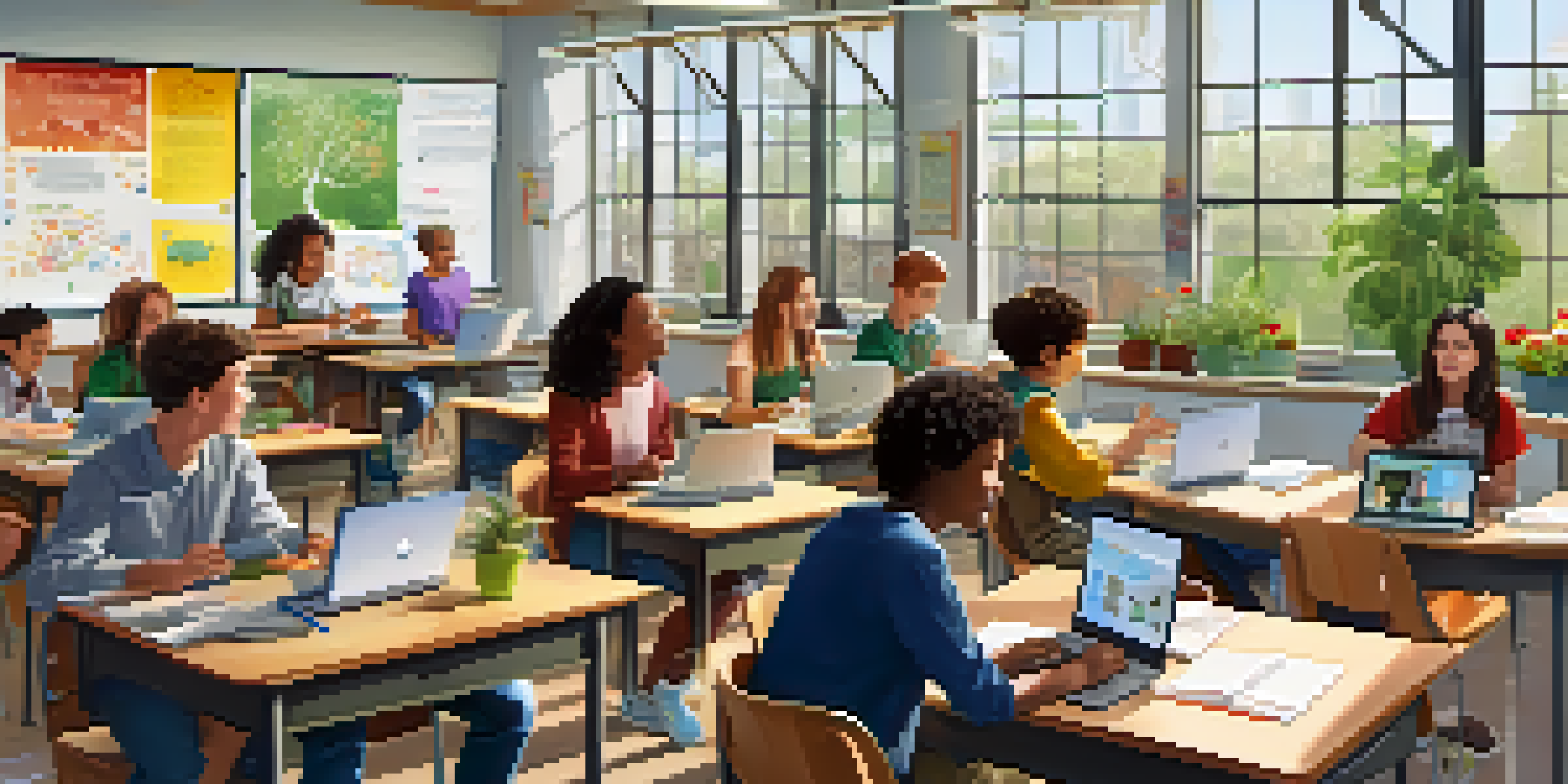The Impact of Blended Learning on Academic Achievement in Schools

Understanding Blended Learning and Its Components
Blended learning combines traditional face-to-face classroom methods with online educational resources. This approach allows students to experience the best of both worlds: personal interaction with teachers and the flexibility of digital learning. For instance, a student might attend lectures in person while accessing supplementary materials or assignments online. This flexible structure fosters a more personalized learning experience tailored to individual needs.
Blended learning is not an event, it’s a process. It’s about creating a rich, interactive environment in which students can flourish.
By integrating technology into the classroom, blended learning encourages students to take control of their education. They can learn at their own pace, revisiting complex topics through online resources or engaging in interactive activities. This adaptability is particularly beneficial for students who may struggle with conventional teaching methods, as they can approach their studies in a way that suits them best. Overall, blended learning promotes a more inclusive and engaging educational environment.
Furthermore, blended learning often incorporates various teaching styles, catering to diverse learning preferences. Visual learners can benefit from videos and graphics, while auditory learners can engage with podcasts or recorded lectures. This multimodal approach not only enhances understanding but also keeps students engaged, making learning more enjoyable and effective.
The Role of Technology in Enhancing Learning Outcomes
Technology plays a pivotal role in blended learning, providing students with access to a wealth of information and resources. With just a few clicks, learners can explore educational platforms, e-books, and interactive simulations that enhance their understanding of complex subjects. This vast array of resources encourages curiosity and facilitates deeper learning, as students can pursue topics that interest them beyond the standard curriculum.

Moreover, tools like learning management systems (LMS) streamline the educational process. Teachers can easily assign tasks, track progress, and provide feedback, creating a more organized learning experience. For example, platforms like Google Classroom allow educators to create a digital classroom where students can collaborate, submit assignments, and receive timely feedback, ultimately leading to improved academic performance.
Blended Learning Combines Best of Both
This educational approach merges traditional classroom methods with online resources, offering flexibility and personalized learning experiences.
Additionally, technology fosters collaboration among peers, which is essential for building critical thinking and problem-solving skills. Students can work together on group projects through shared digital workspaces, regardless of their physical location. This collaboration not only enhances their understanding of the material but also prepares them for the teamwork expected in the modern workforce.
Blended Learning and Student Engagement
One of the standout features of blended learning is its ability to boost student engagement. Traditional classrooms can sometimes feel monotonous, but the incorporation of technology and interactive elements keeps students interested. For instance, gamified learning—where educational concepts are presented as games—can transform a dull lesson into an exciting challenge, motivating students to participate actively.
The future of education is not the classroom, but a blend of online resources and traditional teaching methods that engage and empower students.
When students are engaged, they are more likely to absorb and retain information. By participating in discussions, collaborating on projects, or accessing multimedia resources, learners become active participants in their education. This active involvement not only enhances their understanding but also fosters a positive attitude toward learning, encouraging them to put in more effort.
Moreover, blended learning can cater to various interests, making the curriculum feel more relevant. By incorporating current events, real-world applications, and student interests into lessons, educators can create a rich learning environment that resonates with students. When learners see the connection between their studies and the world around them, they are more likely to remain invested in their education.
Flexibility and Accessibility of Blended Learning
Flexibility is a hallmark of blended learning, allowing students to tailor their educational experience to fit their lifestyles. With online components, students can access materials at their convenience, accommodating different schedules, especially for those balancing school with extracurricular activities or jobs. This flexibility empowers learners to take ownership of their education and manage their time effectively.
Additionally, blended learning makes education more accessible to diverse student populations. For instance, students with disabilities might find online resources easier to navigate, enabling them to learn at their own pace without feeling overwhelmed in a traditional classroom. Educators can also provide various formats of the same material, ensuring that every student has access to the tools they need to succeed.
Technology Enhances Learning Engagement
By integrating technology, blended learning fosters collaboration, creativity, and access to diverse resources, keeping students actively involved.
This accessibility extends beyond the classroom, as students can continue learning from home, enhancing their understanding and retention. Furthermore, the ability to revisit lectures or materials online allows students to reinforce their learning and seek help when needed, ultimately leading to improved academic achievement.
Assessment and Feedback in Blended Learning Environments
Effective assessment is crucial in any educational setting, and blended learning offers innovative ways to evaluate student progress. Traditional tests can be supplemented with online assessments, quizzes, and interactive projects that provide a more comprehensive view of student performance. By using diverse evaluation methods, educators can better understand each student’s strengths and weaknesses.
Moreover, the immediate feedback that online assessments provide is invaluable. Students can receive results right after completing a quiz, allowing them to identify areas for improvement instantly. This real-time feedback loop encourages a growth mindset, as learners can adjust their study habits and focus on mastering challenging concepts rather than waiting for a mid-term report.
Additionally, blended learning fosters a culture of continuous improvement. By combining formative assessments—ongoing evaluations that inform instruction—with summative assessments—final evaluations at the end of a unit—educators can create a responsive learning environment. This approach not only helps students track their progress but also allows teachers to adapt their teaching strategies to meet the evolving needs of their classes.
Challenges and Considerations in Implementing Blended Learning
While blended learning offers numerous benefits, it also presents challenges that educators and institutions must address. One significant hurdle is ensuring that all students have access to the necessary technology and reliable internet connections. In some areas, students may struggle to participate fully in online components, leading to disparities in learning experiences and outcomes.
Additionally, teachers need adequate training and support to implement blended learning effectively. Without proper professional development, educators may feel overwhelmed by the technology or struggle to integrate it into their teaching. Schools must prioritize ongoing training and provide resources to help teachers navigate the blended learning landscape confidently.
Flexibility Makes Education Accessible
Blended learning accommodates various student lifestyles and needs, empowering individuals to manage their education and enhancing overall accessibility.
Lastly, striking the right balance between online and in-person instruction is crucial. Too much reliance on technology can lead to disengagement, while excessive traditional teaching may hinder the benefits of blended learning. Educators must continuously evaluate their approach to create a harmonious blend that maximizes student learning and engagement.
The Future of Blended Learning in Education
As we move forward, blended learning is poised to play a significant role in the future of education. With advancements in technology and changes in learning preferences, schools are increasingly adopting this hybrid model to meet the needs of diverse learners. Educators are now recognizing the potential of blended learning to enhance not just academic achievement but also critical skills like collaboration, creativity, and adaptability.
Moreover, the experiences gained during the pandemic have accelerated the adoption of blended learning strategies. Schools have begun to embrace the flexibility and resilience that this model offers, preparing students for an increasingly digital world. This shift signals a growing recognition of the importance of integrating technology into education and fostering lifelong learning skills.

In conclusion, the impact of blended learning on academic achievement is profound and multifaceted. By combining the strengths of traditional and online education, blended learning creates a more engaging, flexible, and accessible learning environment. As schools continue to evolve, embracing this innovative approach can pave the way for a brighter future for students and educators alike.